Week 15 Ursula K. Le Guin’s utopian parable: "The Ones Who Walk Away from Omelas"
1."The Ones Who Walk Away from Omelas"

"The Ones Who Walk Away from Omelas" is a 1973 plotless, short, descriptive work of philosophical fiction, though popularly classified as a short story, by Ursula K. Le Guin. With deliberately both vague and vivid descriptions, the narrator depicts a summer festival in the utopian city of Omelas, whose prosperity depends on the perpetual misery of a single child."The Ones Who Walk Away from Omelas" was nominated for the Locus Award for Best Short Fiction in 1974 and won the Hugo Award for Best Short Story in 1974.
Le Guin states that the city's name is pronounced "OH-meh-lahss".Le Guin hit upon the name of the town on seeing a road sign for Salem, Oregon, in a car mirror. "[… People ask me] 'Where do you get your ideas from, Ms. Le Guin?' From forgetting Dostoyevsky and reading road signs backwards, naturally. Where else?"
"The central idea of this psychomyth, the scapegoat", writes Le Guin, "turns up in Dostoyevsky's Brothers Karamazov, and several people have asked me, rather suspiciously, why I gave the credit to William James. The fact is, I haven't been able to re-read Dostoyevsky, much as I loved him, since I was twenty-five, and I'd simply forgotten he used the idea. But when I met it in James' 'The Moral Philosopher and the Moral Life,' it was with a shock of recognition.
 Ursula Kroeber Le Guin ( born October 21, 1929) is an American author of novels, children's books, and short stories, mainly in the genres of fantasy and science fiction. She has also written poetry and essays. First published in the 1960s, her work has often depicted futuristic or imaginary alternative worlds in politics, the natural environment, gender, religion, sexuality and ethnography. In 2016, The New York Times described her as "America's greatest living science fiction writer", although she herself has said she would prefer to be known as an "American novelist".
Ursula Kroeber Le Guin ( born October 21, 1929) is an American author of novels, children's books, and short stories, mainly in the genres of fantasy and science fiction. She has also written poetry and essays. First published in the 1960s, her work has often depicted futuristic or imaginary alternative worlds in politics, the natural environment, gender, religion, sexuality and ethnography. In 2016, The New York Times described her as "America's greatest living science fiction writer", although she herself has said she would prefer to be known as an "American novelist".She influenced such Booker Prize winners and other writers as Salman Rushdie and David Mitchell – and notable science fiction and fantasy writers including Neil Gaiman and Iain Banks.She has won the Hugo Award, Nebula Award, Locus Award, and World Fantasy Award, each more than once. In 2014, she was awarded the National Book Foundation Medal for Distinguished Contribution to American Letters.In 2003 she was made a Grandmaster of Science Fiction, one of only a handful of women writers to take the top honour in a genre that has come to be dominated by male writers. Le Guin has resided in Portland, Oregon, since 1959
2.Hugo Gernsback
Hugo Gernsback (August 16, 1884 – August 19, 1967), born Hugo Gernsbacher, was a Luxembourgish-American inventor, writer, editor, and magazine publisher, best known for publications including the first science fiction magazine. His contributions to the genre as publisher were so significant that, along with the novelists H. G. Wells and Jules Verne, he is sometimes called "The Father of Science Fiction". In his honour, annual awards presented at the World Science Fiction Convention are named the "Hugos".
3.Les Misérables

Les Misérables is a French historical novel by Victor Hugo, first published in 1862, that is considered one of the greatest novels of the 19th century. In the English-speaking world, the novel is usually referred to by its original French title. However, several alternatives have been used, including The Miserables, The Wretched, The Miserable Ones, The Poor Ones, The Wretched Poor, The Victims and The Dispossessed.Beginning in 1815 and culminating in the 1832 June Rebellion in Paris, the novel follows the lives and interactions of several characters, particularly the struggles of ex-convict Jean Valjean and his experience of redemption.
Examining the nature of law and grace, the novel elaborates upon the history of France, the architecture and urban design of Paris, politics, moral philosophy, antimonarchism, justice, religion, and the types and nature of romantic and familial love. Les Misérables has been popularized through numerous adaptations for the stage, television, and film, including a musical and a film adaptation of that musical.
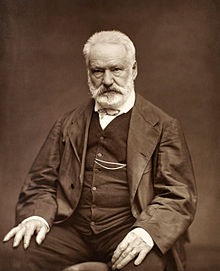 Victor Marie Hugo (26 February 1802 – 22 May 1885) was a French poet, novelist, and dramatist of the Romantic movement. He is considered one of the greatest and best-known French writers. Outside France, his best-known works are the novels Les Misérables, 1862, and The Hunchback of Notre-Dame (French: Notre-Dame de Paris), 1831. In France, Hugo is known primarily for his poetry collections, such as Les Contemplations (The Contemplations) and La Légende des siècles (The Legend of the Ages). He produced more than 4,000 drawings and also campaigned for social causes such as the abolition of capital punishment.
Victor Marie Hugo (26 February 1802 – 22 May 1885) was a French poet, novelist, and dramatist of the Romantic movement. He is considered one of the greatest and best-known French writers. Outside France, his best-known works are the novels Les Misérables, 1862, and The Hunchback of Notre-Dame (French: Notre-Dame de Paris), 1831. In France, Hugo is known primarily for his poetry collections, such as Les Contemplations (The Contemplations) and La Légende des siècles (The Legend of the Ages). He produced more than 4,000 drawings and also campaigned for social causes such as the abolition of capital punishment.Though a committed royalist when he was young, Hugo's views changed as the decades passed, and he became a passionate supporter of republicanism; his work touches upon most of the political and social issues and the artistic trends of his time. He is buried in the Panthéon in Paris. His legacy has been honoured in many ways, including his portrait being placed on French currency.
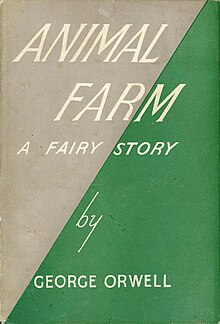 4.Animal Farm is an allegorical novella by George Orwell, first published in England on 17 August 1945. According to Orwell, the book reflects events leading up to the Russian Revolution of 1917 and then on into the Stalinist era of the Soviet Union.Orwell, a democratic socialist, was a critic of Joseph Stalin and hostile to Moscow-directed Stalinism, an attitude that was critically shaped by his experiences during the Spanish Civil War. The Soviet Union, he believed, had become a brutal dictatorship, built upon a cult of personality and enforced by a reign of terror. In a letter to Yvonne Davet, Orwell described Animal Farm as a satirical tale against Stalin ("un conte satirique contre Staline"), and in his essay "Why I Write" (1946), wrote that Animal Farm was the first book in which he tried, with full consciousness of what he was doing, "to fuse political purpose and artistic purpose into one whole".
4.Animal Farm is an allegorical novella by George Orwell, first published in England on 17 August 1945. According to Orwell, the book reflects events leading up to the Russian Revolution of 1917 and then on into the Stalinist era of the Soviet Union.Orwell, a democratic socialist, was a critic of Joseph Stalin and hostile to Moscow-directed Stalinism, an attitude that was critically shaped by his experiences during the Spanish Civil War. The Soviet Union, he believed, had become a brutal dictatorship, built upon a cult of personality and enforced by a reign of terror. In a letter to Yvonne Davet, Orwell described Animal Farm as a satirical tale against Stalin ("un conte satirique contre Staline"), and in his essay "Why I Write" (1946), wrote that Animal Farm was the first book in which he tried, with full consciousness of what he was doing, "to fuse political purpose and artistic purpose into one whole".The original title was Animal Farm: A Fairy Story; U.S. publishers dropped the subtitle when it was published in 1946, and only one of the translations during Orwell's lifetime kept it. Other titular variations include subtitles like "A Satire" and "A Contemporary Satire".Orwell suggested the title Union des républiques socialistes animales for the French translation, which abbreviates to URSA, the Latin word for "bear", a symbol of Russia. It also played on the French name of the Soviet Union, Union des républiques socialistes soviétiques.
Orwell wrote the book between November 1943 and February 1944, when the UK was in its wartime alliance with the Soviet Union and the British people and intelligentsia held Stalin in high esteem, a phenomenon Orwell hated. The manuscript was initially rejected by a number of British and American publishers,including one of Orwell's own, Victor Gollancz, which delayed its publication. It became a great commercial success when it did appear partly because international relations were transformed as the wartime alliance gave way to the Cold War
Eric Arthur Blair (25 June 1903 – 21 January 1950), better known by his pen name George Orwell, was an English novelist, essayist, journalist, and critic. His work is marked by lucid prose, awareness of social injustice, opposition to totalitarianism, and outspoken support of democratic socialism.
Orwell wrote literary criticism, poetry, fiction, and polemical journalism. He is best known for the allegorical novella Animal Farm (1945) and the dystopian novel Nineteen Eighty-Four (1949). Documenting his experience of working class life in the north of England, and Homage to Catalonia (1938), an account of his experiences in the Spanish Civil War, are widely acclaimed, as are his essays on politics, literature, language, and culture. In 2008, The Times ranked him second on a list of "The 50 greatest British writers since 1945".
 5.Brave New World is a novel written in 1931 by Aldous Huxley, and published in 1932. Set in London in the year AD 2540 (632 A.F.—"After Ford"—in the book), the novel anticipates developments in reproductive technology, sleep-learning, psychological manipulation, and classical conditioning that are combined to profoundly change society. Huxley answered this book with a reassessment in an essay, Brave New World Revisited (1958), and with Island (1962), his final novel.
5.Brave New World is a novel written in 1931 by Aldous Huxley, and published in 1932. Set in London in the year AD 2540 (632 A.F.—"After Ford"—in the book), the novel anticipates developments in reproductive technology, sleep-learning, psychological manipulation, and classical conditioning that are combined to profoundly change society. Huxley answered this book with a reassessment in an essay, Brave New World Revisited (1958), and with Island (1962), his final novel.In 1999, the Modern Library ranked Brave New World fifth on its list of the 100 best English-language novels of the 20th century.In 2003, Robert McCrum writing for The Observer included Brave New World chronologically at number 53 in "the top 100 greatest novels of all time", and the novel was listed at number 87 on the BBC's survey The Big Read.
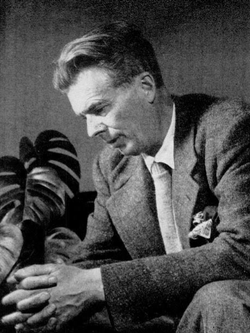
Aldous Leonard Huxley ( 26 July 1894 – 22 November 1963) was an English writer, novelist, philosopher, and prominent member of the Huxley family. He graduated from Balliol College at the University of Oxford with a first-class honours in English literature.
He was best known for his novels including Brave New World, set in a dystopian future; for non-fiction books, such as The Doors of Perception, which recalls experiences when taking a psychedelic drug; and a wide-ranging output of essays. Early in his career Huxley edited the magazine Oxford Poetry and published short stories and poetry. Mid career and later, he published travel writing, film stories, and scripts. He spent the later part of his life in the United States, living in Los Angeles from 1937 until his death. In 1962, a year before his death, he was elected Companion of Literature by the Royal Society of Literature.
Huxley was a humanist, pacifist, and satirist. He later became interested in spiritual subjects such as parapsychology and philosophical mysticism, in particular universalism. By the end of his life, Huxley was widely acknowledged as one of the pre-eminent intellectuals of his time. He was nominated for the Nobel Prize in Literature in seven different years.
The Handmaid's Tale won the 1985 Governor General's Award and the first Arthur C. Clarke Award in 1987; it was also nominated for the 1986 Nebula Award, the 1986 Booker Prize, and the 1987 Prometheus Award. The book has been adapted into a film (1990), an opera (2000), a TV series (2017), and other media.
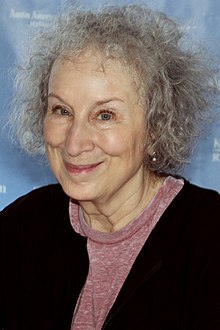 Margaret Eleanor Atwood, (born November 18, 1939) is a Canadian poet, novelist, literary critic, essayist, and environmental activist. She is a winner of the Arthur C. Clarke Award and Prince of Asturias Award for Literature, has been shortlisted for the Booker Prize five times, winning once, and has been a finalist for the Governor General's Award several times, winning twice. In 2001, she was inducted into Canada's Walk of Fame. She is also a founder of the Writers' Trust of Canada, a non-profit literary organization that seeks to encourage Canada's writing community.[3] Among innumerable contributions to Canadian literature, she was a founding trustee of the Griffin Poetry Prize.
Margaret Eleanor Atwood, (born November 18, 1939) is a Canadian poet, novelist, literary critic, essayist, and environmental activist. She is a winner of the Arthur C. Clarke Award and Prince of Asturias Award for Literature, has been shortlisted for the Booker Prize five times, winning once, and has been a finalist for the Governor General's Award several times, winning twice. In 2001, she was inducted into Canada's Walk of Fame. She is also a founder of the Writers' Trust of Canada, a non-profit literary organization that seeks to encourage Canada's writing community.[3] Among innumerable contributions to Canadian literature, she was a founding trustee of the Griffin Poetry Prize.Atwood is also the inventor, and developer, of the LongPen and associated technologies that facilitate the remote robotic writing of documents. She is the Co-Founder and a Director of Syngrafii Inc. (formerly Unotchit Inc.), a company that she started in 2004 to develop, produce and distribute the LongPen technology. She holds various patents related to the LongPen technologies.
The top three Fantasy Series
1.Earthsea is a series of fantasy books by the American writer Ursula K. Le Guin, and the name of their setting, a world of islands surrounded by an uncharted ocean. Starting with a short story, "The Word of Unbinding" in 1964, there are six Earthsea books, beginning with A Wizard of Earthsea in 1968, and continuing with The Tombs of Atuan, The Farthest Shore, Tehanu, and The Other Wind. There are eight short stories, all but "The Daughter of Odren" now collected in The Wind's Twelve Quarters and Tales from Earthsea.
2.The Lord of the Rings is an epic high-fantasy novel written by English author J. R. R. Tolkien. The story began as a sequel to Tolkien's 1937 fantasy novel The Hobbit, but eventually developed into a much larger work. Written in stages between 1937 and 1949, The Lord of the Rings is one of the best-selling novels ever written, with over 150 million copies sold.
3.The Chronicles of Narnia is a series of seven fantasy novels by C. S. Lewis. It is considered a classic of children's literature and is the author's best-known work, having sold over 100 million copies in 47 languages. Written by Lewis, illustrated by Pauline Baynes, and originally published in London between 1950 and 1956, The Chronicles of Narnia has been adapted several times, complete or in part, for radio, television, the stage, and film.
7.Le Transperceneige (The Snow-Piercer) is a science fiction post-apocalyptic French graphic novel created by Jacques Lob and Jean-Marc Rochette, and published by Casterman. The graphic novel was first published in 1982 under the title Le Transperceneige, and later retitled The Escape. The series was continued in two volumes by writer Benjamin Legrand, replacing Jacques Lob, with The Explorers published in 1999 and The Crossing in 2000. A fourth volume, Terminus, was written by Olivier Bocquet and published in 2015, as a conclusion to the series.
8. Allegory is a metaphor whose vehicle may be a character, place or event, representing real-world issues and occurrences. Allegory has been used widely throughout history in all forms of art, largely because it can readily illustrate complex ideas and concepts in ways that are comprehensible or striking to its viewers, readers, or listeners.
Writers or speakers typically use allegories as literary devices or as rhetorical devices that convey hidden meanings through symbolic figures, actions, imagery, or events, which together create the moral, spiritual, or political meaning the author wishes to convey.
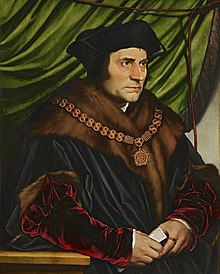 7. Sir Thomas More (7 February 1478 – 6 July 1535), venerated by Roman Catholics as Saint Thomas More,was an English lawyer, social philosopher, author, statesman and noted Renaissance humanist. He was also a councillor to Henry VIII, and Lord High Chancellor of England from October 1529 to 16 May 1532.He also wrote Utopia, published in 1516, about the political system of an imaginary ideal island nation.
7. Sir Thomas More (7 February 1478 – 6 July 1535), venerated by Roman Catholics as Saint Thomas More,was an English lawyer, social philosopher, author, statesman and noted Renaissance humanist. He was also a councillor to Henry VIII, and Lord High Chancellor of England from October 1529 to 16 May 1532.He also wrote Utopia, published in 1516, about the political system of an imaginary ideal island nation.More opposed the Protestant Reformation, in particular the theology of Martin Luther and William Tyndale. More also opposed the King's separation from the Catholic Church, refusing to acknowledge Henry as Supreme Head of the Church of England and the annulment of his marriage to Catherine of Aragon. After refusing to take the Oath of Supremacy, he was convicted of treason and beheaded. Of his execution, he was reported to have said: "I die the King's good servant, but God's first."
Pope Pius XI canonised More in 1935 as a martyr. Pope John Paul II in 2000 declared him the "heavenly Patron of Statesmen and Politicians."Since 1980, the Church of England has remembered More liturgically as a Reformation martyr.The Soviet Union honoured him for the Communist attitude toward property rights expressed in Utopia
Veneration or veneration of saints, is the act of honoring a saint, a person who has been identified as having a high degree of sanctity or holiness.Angels are shown similar veneration in many religions. Philologically, "to venerate" derives from the Latin verb, venerare, meaning to regard with reverence and respect. Veneration of saints is practiced, formally or informally, by adherents of some branches of all major religions, including Christianity, Judaism,Hinduism,Islam,and Buddhism.
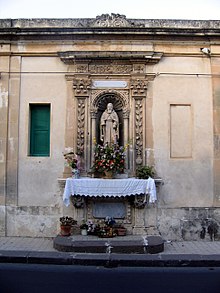 Within Christianity, veneration is practiced by groups such as the Eastern Orthodox Church, the Roman Catholic, and Eastern Catholic Churches, all of which have varying types of canonization or glorification procedures. In the Catholic and Orthodox Churches, veneration is shown outwardly by respectfully bowing or making the sign of the cross before a saint's icon, relics, or statue, or by going on pilgrimage to sites associated with saints. In general, veneration is not practiced by Protestants, with some denominations considering these practices heretical.
Within Christianity, veneration is practiced by groups such as the Eastern Orthodox Church, the Roman Catholic, and Eastern Catholic Churches, all of which have varying types of canonization or glorification procedures. In the Catholic and Orthodox Churches, veneration is shown outwardly by respectfully bowing or making the sign of the cross before a saint's icon, relics, or statue, or by going on pilgrimage to sites associated with saints. In general, veneration is not practiced by Protestants, with some denominations considering these practices heretical.Hinduism has a long tradition of veneration of saints, expressed toward various gurus and teachers of sanctity, both living and dead. Branches of Buddhism include formal liturgical worship of saints, with Mahayana Buddhism classifying degrees of sainthood.
In Islam, veneration of saints is practiced by the adherents of Sunni Islam (for example Barelvism etc), Shia Islam and Sufism, and in many parts of Southeast Asia, along with "folk Islam", which often incorporates local beliefs and practices. Other sects, such as Wahhabists etc., abhor the practice.
In Judaism, there is no classical or formal recognition of saints, but there is a long history of reverence shown toward biblical heroes and martyrs. In some regions, for example within Judaism in Morocco, there is a long and widespread tradition of saint veneration.
9.A parable is a succinct, didactic story, in prose or verse, which illustrates one or more instructive lessons or principles. It differs from a fable in that fables employ animals, plants, inanimate objects, or forces of nature as characters, whereas parables have human characters. A parable is a type of analogy.
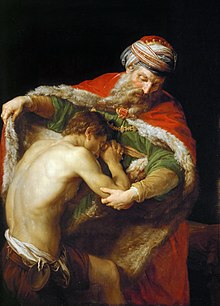 Some scholars of the canonical gospels and the New Testament apply the term "parable" only to the parables of Jesus,though that is not a common restriction of the term. Parables such as "The Prodigal Son" are central to Jesus' teaching method in the canonical narratives and the apocrypha.
Some scholars of the canonical gospels and the New Testament apply the term "parable" only to the parables of Jesus,though that is not a common restriction of the term. Parables such as "The Prodigal Son" are central to Jesus' teaching method in the canonical narratives and the apocrypha.The Parable of the Prodigal Son (also known as the Two Brothers, Lost Son, Loving Father, or Lovesick Father) is one of the parables of Jesus and appears in Luke 15:11–32. Jesus Christ shares it with his disciples, the Pharisees and others.
In the story, a father has two sons. The younger son asks for his inheritance and after wasting his fortune (the word "prodigal" means "wastefully extravagant"), becomes destitute. He returns home with the intention of begging his father to be made one of his hired servants, expecting his relationship with his father is likely severed. The father welcomes him back and celebrates his return. The older son refuses to participate. The father reminds the older son that one day he will inherit everything. But, they should still celebrate the return of the younger son because he was lost and is now found.
It is the third and final part of a cycle on redemption, following the Parable of the Lost Sheep and the Parable of the Lost Coin. In Revised Common Lectionary and Latin Rite Catholic Lectionary, this parable is read on the fourth Sunday of Lent (in Year C),in the latter it is also included in the long form of the Gospel on the 24th Sunday of Ordinary Time in Year C, along with the preceding two parables of the cycle.In the Eastern Orthodox Church it is read on the Sunday of the Prodigal Son.
The Film
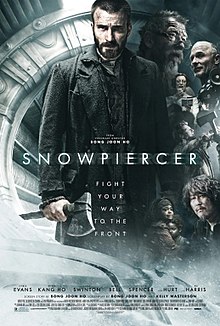 1. Snowpiercer is a 2013 English-language South Korean-Czech science fiction thriller film based on the French graphic novel Le Transperceneige by Jacques Lob, Benjamin Legrand and Jean-Marc Rochette. The film is directed by Bong Joon-ho,and written by Bong and Kelly Masterson. The film marks Bong's English-language debut; approximately 80% of the film was shot in English.
1. Snowpiercer is a 2013 English-language South Korean-Czech science fiction thriller film based on the French graphic novel Le Transperceneige by Jacques Lob, Benjamin Legrand and Jean-Marc Rochette. The film is directed by Bong Joon-ho,and written by Bong and Kelly Masterson. The film marks Bong's English-language debut; approximately 80% of the film was shot in English.Snowpiercer was well received by critics, and appeared on many film critics' top ten film lists of 2014 following its international release. Praise was primarily directed towards its vision, direction, and performances, particularly Evans's and Swinton's. Initially planned for a limited-screen showing in the United States, the critical response to the film prompted The Weinstein Company to expand the showing to more theaters and through digital streaming services. Produced at a budget of $40 million, it remains as the most expensive Korean production ever.
 Bong Joon Ho ( born September 14, 1969) is a South Korean film director and screenwriter. His films include South Korean hits Memories of Murder (2003), based on a true-life serial murder case, monster movie The Host (2006), and his first English-language film, science fiction adventure Snowpiercer (2013).
Bong Joon Ho ( born September 14, 1969) is a South Korean film director and screenwriter. His films include South Korean hits Memories of Murder (2003), based on a true-life serial murder case, monster movie The Host (2006), and his first English-language film, science fiction adventure Snowpiercer (2013).Korean film industry insiders have nicknamed him "Bong Tae-il," which, pronounced in Korean, sounds similar to the word "detail". Though he displays a fascination for strong subject matter, his films are filled with (often black) humor and sudden mood shifts.
 2. Elysium is a 2013 American science fiction film produced, written and directed by Neill Blomkamp. It stars Matt Damon, Jodie Foster, Alice Braga, and Sharlto Copley.The film takes place on both a ravaged Earth, and a luxurious space habitat (Stanford torus design) called Elysium. The film itself offers deliberate social commentary which explores political and sociological themes such as immigration, overpopulation, health care, worker exploitation, the justice system, and social class issues. The film was released on August 9, 2013 by TriStar Pictures, in both conventional and IMAX Digital theaters. It was a modest success and received generally positive reviews from critics, even though many considered it a disappointment after Blomkamp's first film District 9. Elysium was released on DVD and Blu-ray discs in Region 1 on December 17, 2013.
2. Elysium is a 2013 American science fiction film produced, written and directed by Neill Blomkamp. It stars Matt Damon, Jodie Foster, Alice Braga, and Sharlto Copley.The film takes place on both a ravaged Earth, and a luxurious space habitat (Stanford torus design) called Elysium. The film itself offers deliberate social commentary which explores political and sociological themes such as immigration, overpopulation, health care, worker exploitation, the justice system, and social class issues. The film was released on August 9, 2013 by TriStar Pictures, in both conventional and IMAX Digital theaters. It was a modest success and received generally positive reviews from critics, even though many considered it a disappointment after Blomkamp's first film District 9. Elysium was released on DVD and Blu-ray discs in Region 1 on December 17, 2013. Neill Blomkamp (born 17 September 1979) is a South African–Canadian film director, film producer, screenwriter, and animator. Blomkamp employs a documentary-style, hand-held, cinéma vérité technique, blending naturalistic and photo-realistic computer-generated effects. He is best known as the co-writer and director of the critically acclaimed and financially successful science fiction film District 9 and the dystopian science fiction film Elysium, which garnered moderately positive reviews and a good box office return. He is also known for his collaborations with South African actor Sharlto Copley. He is based in Vancouver, British Columbia.
Neill Blomkamp (born 17 September 1979) is a South African–Canadian film director, film producer, screenwriter, and animator. Blomkamp employs a documentary-style, hand-held, cinéma vérité technique, blending naturalistic and photo-realistic computer-generated effects. He is best known as the co-writer and director of the critically acclaimed and financially successful science fiction film District 9 and the dystopian science fiction film Elysium, which garnered moderately positive reviews and a good box office return. He is also known for his collaborations with South African actor Sharlto Copley. He is based in Vancouver, British Columbia.
a 2005 American science fiction-thriller film directed by Michael Bay, starring Ewan McGregor and Scarlett Johansson. It was released on July 22, 2005 in the United States, and was nominated for three awards, including the Teen Choice Award.
It is described as a pastiche of "escape-from-dystopia" science fiction films of the 1960s and 1970s such as Fahrenheit 451, THX 1138, Parts: The Clonus Horror, and Logan's Run. The film's plot revolves around the struggle of McGregor's character to fit into the highly structured world he lives in, isolated in a compound, and the series of events that unfold when he questions how truthful that world is. After he learns the compound inhabitants are clones used for organ harvesting and surrogate motherhood for wealthy people in the outside world, he escapes.
 Michael Benjamin Bay (born February 17, 1965) is an American filmmaker known for directing and producing big-budget action films characterized by fast cutting, stylistic visuals and extensive use of special effects, including frequent depictions of explosions. The films he has produced and directed, which include Armageddon (1998), Pearl Harbor (2001) and the Transformers film series (2007–present), have grossed over US$7.8 billion worldwide.[4][5] He is co-founder of commercial production house The Institute, a.k.a. The Institute for the Development of Enhanced Perceptual Awareness.
Michael Benjamin Bay (born February 17, 1965) is an American filmmaker known for directing and producing big-budget action films characterized by fast cutting, stylistic visuals and extensive use of special effects, including frequent depictions of explosions. The films he has produced and directed, which include Armageddon (1998), Pearl Harbor (2001) and the Transformers film series (2007–present), have grossed over US$7.8 billion worldwide.[4][5] He is co-founder of commercial production house The Institute, a.k.a. The Institute for the Development of Enhanced Perceptual Awareness.
Despite his considerable success at the international box office, Bay's work is generally held in low esteem by film critics. While The Rock (1996) and Transformers (2007) received moderately positive reviews, his other films, including the three Transformers sequels, have been received negatively by critics.

4. Demolition Man is a 1993 American science fiction action film directed by Marco Brambilla in his directorial debut. The film stars Sylvester Stallone and Wesley Snipes. The film was released in the United States on October 8, 1993.
The film tells the story of two men: an evil crime lord and a risk-taking police officer. Cryogenically frozen in 1996, they are restored to life in the year 2032 to find mainstream society changed and all crime seemingly eliminated.



0 個意見:
張貼留言
訂閱 張貼留言 [Atom]
<< 首頁